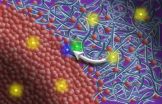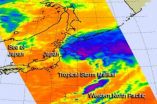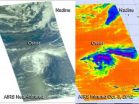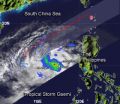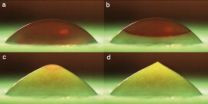(Press-News.org) Controlling "mixing" between acceptor and donor layers, or domains, in polymer-based solar cells could increase their efficiency, according to a team of researchers that included physicists from North Carolina State University. Their findings shed light on the inner workings of these solar cells, and could lead to further improvements in efficiency.
Polymer-based solar cells consist of two domains, known as the acceptor and the donor layers. Excitons, the energy particles created by solar cells, must be able to travel quickly to the interface of the donor and acceptor domains in order to be harnessed as an energy source. Researchers had believed that keeping the donor and acceptor layers as pure as possible was the best way to ensure that the excitons could travel unimpeded, so that solar cells could capture the maximum amount of energy.
NC State physicist Harald Ade and his group worked with teams of scientists from the United Kingdom, Australia and China to examine the physical structure and improve the production of polymer-based solar cells. In findings published in two separate papers appearing this month online in Advanced Energy Materials and Advanced Materials, the researchers show that some mixing of the two domains may not be a bad thing. In fact, if the morphology, or structure, of the mixed domains is small, the solar cell can still be quite efficient.
According to Ade, "We had previously found that the domains in these solar cells weren't pure. So we looked at how additives affected the production of these cells. When you manufacture the cell, the relative rate of evaporation of the solvents and additives determines how the active layer forms and the donor and acceptor mix. Ideally, you want the solvent to evaporate slowly enough so that the materials have time to separate – otherwise the layers 'gum up' and lower the cell's efficiency. We utilized an additive that slowed evaporation. This controlled the mixing and domain size of the active layer, and the portions that mixed were small."
The efficiency of those mixed layers was excellent, leading to speculation that perhaps some mixing of the donor and acceptor isn't a problem, as long as the domains are small.
"We're looking for the perfect mix here, both in terms of the solvents and additives we might use in order to manufacture polymer-based solar cells, and in terms of the physical mixing of the domains and how that may affect efficiency," Ade says.
INFORMATION:
The research was funded by the U.S. Department of Energy. Ade is corresponding author on the Advanced Energy Materials paper, with post docs Brian Collins, John Tumbleston and graduate student Eliot Gann contributing to the work. Dr. Zhe Li of the University of Cambridge and Christopher McNeill of Monash University in Australia also contributed. Ade was a contributing author on the Advanced Materials paper, which was co-authored by Ade's post doc Wei Ma and Professor Jianhui Hou of Beijing's Chinese Academy of Sciences.
Note to editors: Abstracts follow.
"From Binary to Ternary Solvent: Morphology Fine-tuning of D/A Blend in PDPP3T-based Polymer Solar Cells"
Published: Advanced Materials
Authors: L. Ye, S. Zhang, B. Fan, X. Guo, Y. Huang, Prof. J. Hou, State Key Laboratory of Polymer Physics and Chemistry, Beijing National Laboratory for Molecular Sciences, Institute of Chemistry, Chinese Academy of Sciences; W. Ma, H. Ade, North Carolina State University
Abstract: In the past decade, great success has been achieved in bulk hetero-junction (BHJ) polymer solar cells (PSCs) in which donor/acceptor (D/A) bi-continuous interpenetrating networks can be formed and in some recent reports, power conversion efficiency (PCE) even approach 8%. In addition to the intrinsic properties of active layer materials, such as band gaps and molecular energy levels, morphological properties of the D/A blends including crystallinity of polymers, domain size, materials miscibility, hierarchical structures, and molecular orientation, are also of great importance for photovoltaic performance of the devices. Therefore, several strategies including slow growth, solvent annealing, thermal annealing, selection of solvent or mixed solvent have been applied to modify or control of the morphology of the D/A blends. Among these, binary solvent mixtures have been successfully used in morphology control. For example, the dichlorobenzene (DCB) or chlorobenzene (CB)/1, 8-diiodooctane (DIO) binary solvent system has been widely applied in PSC device fabrication process. By mixing a few volume percent of DIO with the host solvent (DCB or CB), efficiencies of many kinds of polymers can be improved dramatically. Besides DIO, other solvents, like 1, 8-octanedithiol (OT), N-methyl-2-pyrrolidone (NMP), 1-chloronaphthalene (CN), chloroform (CF), can also be used. According to these works, it can be concluded that crystallinity, as well as domain size in the blends can be tuned effectively by using binary solvent mixtures, and thus binary solvent mixtures play a very important role in high performance PSCs.
"Absolute measurement of domain composition and nanoscale size distribution explains performance in PTB7:PC71BM solar cells."
Published: Advanced Energy Materials
Authors: Brian A. Collins, John R. Tumbleston, Eliot Gann, Harald Ade, North Carolina State University; Zhe Li, University of Cambridge, Cambridge U.K.; Christopher R. McNeill, Monash University, Australia
Abstract:
The vital importance of morphology on organic solar cell performance is well known, but to date, the lack of quantitative, nanoscale and statistical morphological information has hindered obtaining direct links to device function. Here resonant x-ray scattering and microscopy are combined to quantitatively measure the nanoscale domain size, distribution and composition in high efficiency solar cells based on PTB7 and PC71BM. The results show that that the solvent additive diiodooctane dramatically shrinks the domain size of pure fullerene agglomerates that are embedded in a polymer-rich 70/30 wt.% molecularly mixed matrix, while preserving the domain composition relative to additive-free devices. The fundamental miscibility between the species – measured to be equal to the device's matrix composition – is likely the dominant factor behind the overall morphology with the additive affecting the dispersion of excess fullerene. As even the molecular ordering measured by x-ray diffraction is unchanged between the two processing routes the change in the distribution of domain size and therefore increased domain interface is primarily responsible for the dramatic increase in device performance. While fullerene exciton harvesting is clearly one significant cause of the increase owing to smaller domains, a measured increase in harvesting from the polymer species indicates that the molecular mixing is not the reason for the high efficiency in this system. Rather, excitations in the polymer likely require proximity to a pure fullerene phase for efficient charge separation and transport. Furthermore, in contrast to previous measurements on a PTB7-based system, a hierarchical morphology was not observed, indicating that it is not necessary for high performance.
Researchers reveal how solvent mixtures affect organic solar cell structure
2012-10-05
ELSE PRESS RELEASES FROM THIS DATE:
Improving confidence keeps breast cancer survivors exercising
2012-10-05
CORVALLIS, Ore. – More than 40 percent of older breast cancer survivors are insufficiently active after leaving a supervised program. But new research shows that those women who developed behavioral skills such as self-confidence and motivation during their program were far more likely to continue exercising on their own.
Regular exercise may reduce the risk of breast cancer recurrence and breast cancer-related mortality, experts say, making it crucial to effectively target breast cancer survivors who do not engage in regular physical activity for interventions.
Researchers ...
Why we need insects -- even 'pesky' ones
2012-10-05
At first blush, many people would probably love to get rid of insects, such as pesky mosquitoes, ants and roaches. But a new study indicates that getting rid of insects could trigger some unwelcome ecological consequences, such as the rapid loss of desired traits in plants, including their good taste and high yields.
Specifically, the study--described in the Oct. 5, 2012 issue of Science and funded by the National Science Foundation showed that evening primroses grown in insecticide-treated plots quickly lost, through evolution, defensive traits that helped protect them ...
MU researcher identifies factors to help parents and professionals recognize teens in distress
2012-10-05
Suicide is the third-leading cause of death for teens, according to the Centers for Disease Control and Prevention. Now, a University of Missouri public health expert has identified factors that will help parents, medical professionals and educators recognize teens at risk for self injury and suicide.
"For many young people, suicide represents an escape from unbearable situations—problems that seem impossible to solve or negative emotions that feel overwhelming," said Lindsay Taliaferro, an assistant professor of health sciences at MU. "Adults can help these teens dissect ...
Sandia Labs benchmark helps wind industry measure success
2012-10-05
ALBUQUERQUE, N.M. – Sandia National Laboratories published the second annual 2012 Wind Plant Reliability Benchmark on Monday, and the results should help the nation's growing wind industry benchmark its performance, understand vulnerabilities and enhance productivity.
Until now, wind farm owners and operators had no way to compare their output with the output of similar operations. To benchmark the reliability of the U.S. wind turbine fleet and identify major causes of failures and downtime, the DOE commissioned Sandia in 2010 to build the Continuous Reliability Enhancement ...
Far, far beyond wrist radios
2012-10-05
To believe that technologies once dreamed of in science fiction novels, television shows, and comic strips may one day be a reality, or that real-world technologies might make the fantastic devices of fiction obsolete, you'd need to be either an optimist…or a futurist in the Department of Homeland Security (DHS)'s Science and Technology Directorate (S&T).
To keep dreams grounded, S&T maintains a team of futurists in Arlington, Va., at the Homeland Security Studies & Analysis Institute (HSSAI). There, in the Resilience and Emergency Preparedness / Response Branch, analysts ...
NASA sees Tropical Storm Maliksi put final touches on Japan
2012-10-05
Tropical Storm Maliksi is putting the final touches on Japan, that is, the edge of the storm was seen brushing the country's northern coast as it pulled away on NASA satellite imagery.
NASA's Aqua satellite passed over Tropical Storm Maliksi on Oct. 4 at 0329 UTC (11:29 p.m. EDT, Oct. 3, EDT) and the Atmospheric Infrared Sounder (AIRS) instrument captured an infrared image of the storm brushing the Tohoku and Hokkaido prefectures of northern Japan.
On Oct. 4, 2012 at 1500 UTC (11 a.m. EDT), the Joint Typhoon Warning Center issued their final advisory on Maliksi. At ...
NASA gets 2 infrared views of tropical storms Nadine, Oscar
2012-10-05
NASA's Aqua satellite provided two different infrared views of the two tropical storms swirling in the Atlantic Ocean. Oscar is battling wind shear that appears destined to tear it apart, while Nadine is merging with a cold front.
NASA's Aqua satellite passed over both Tropical Storm Nadine and Tropical Depression 15 (TD15) on Oct. 3 at 1553 UTC (11:53 a.m. EDT), before TD15 became Tropical Storm Oscar. While overhead, the Atmospheric Infrared Sounder (AIRS) instrument aboard Aqua captured two different images of both storms. One image was near infrared and almost visible ...
NASA sees Tropical Storm Gaemi's heaviest rainfall around center
2012-10-05
Some of the most powerful thunderstorms in a tropical cyclone surround the center of circulation, and NASA's TRMM satellite noticed that rainfall is heaviest in that area of Tropical Storm Gaemi.
When NASA's Tropical Rainfall Measuring Mission (TRMM) satellite passed over Tropical Storm Gaemi on Oct. 3 at 1241 UTC (8:41 a.m. EDT), the precipitation radar instrument detected light rainfall occurring over most of the storm. Moderate rain was falling at a rate between .78 to 1.57 inches/20 to 40 mm per hour and surrounded a small area of heavy rainfall circling tightly around ...
Freezing water droplets form sharp ice peaks
2012-10-05
Researchers at the University of Twente, in the Netherlands, placed water droplets on a plate chilled to -20 degrees Celsius and captured images as a freezing front traveled up the droplet. The photos are published in the American Institute of Physics' (AIP) journal Physics of Fluids. The approximately 4-millimeter diameter droplets took about 20 seconds to freeze. During the final stage of freezing, the ice drop developed a pointy tip, as can be seen in Figure 1d. The effect, which is not observed for most other liquids, arises because water expands as it freezes. The ...
IntuiTouch Technologies Announces Development of ChiroSpring Practice Management Software
2012-10-05
"ChiroSpring is unique in the chiropractic software industry because it combines the most advanced technology with a design that couldn't be easier to use," said Brian Albery, CEO of ChiroSpring. "Doctors want electronic chiropractic software that allows their practice to run at maximum efficiency, but is also easy and intuitive to operate. While other chiropractor software programs force you to choose between functionality and simplicity, ChiroSpring offers an unbeatable combination of both. The best chiropractic software should give doctors everything they ...
